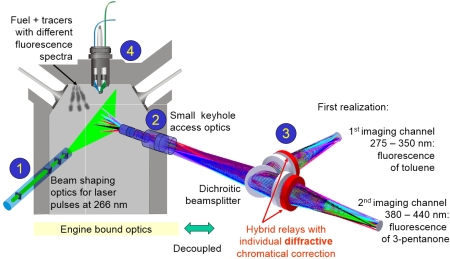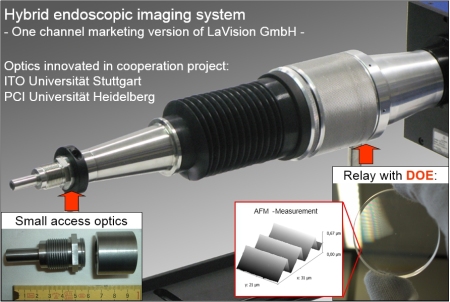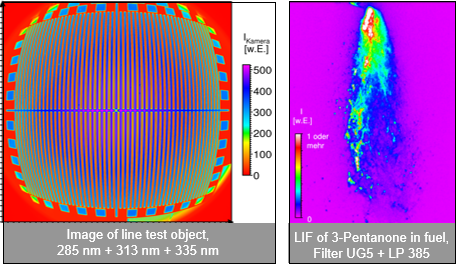These concepts are further developed and evaluated by our project partner, the group of Prof. Schulz (now at IVG, University of Duisburg). For realistic tracer concentrations, however, even upon strong laser excitation and detection through large access windows the resulting signals are quite weak. This disadvantage has shown to be a very limiting factor for minimal invasive application, so for only slightly modified production engines no UV-LIF results were found. To overcome these problems a cooperation project was initiated, in which we designed and realized several optics for optimized excitation and very high lens speed on the detection side to enable UV-LIF keyhole applications with multiple tracers in 1D and 2D. In a follow-up project also a keyhole 3D-position analysis was investigated for special situations. An overview of the optics and the corresponding application setups is given in figure 1.

Fig. 1: Application setups for keyhole 2D-UV-LIF-measurements with excitation (1) and imaging optics (2 and 3) and fiber optic spark plug sensor for single point UV-LIF-measurements (4).
Optics 1: Beam-shaping optics for excitation
For the excitation of the tracer substances and thus the spatial definition of the measurement positions several divergent profile generators for high power were designed and realized, for example a tophat-like lightsheet profile. For further details see [1].
Optics 2, 3: High lens speed diffractive-refractive (hybrid) imaging system
The hybrid imaging system consists of a small access optics without specific chromatic correction elements and several large relay elements with individual chromatic correction for different fluorescence bands. Here, a very strong chromatic correction is required, which is realized by the negative dispersion of diffractive lenses. This special approach provides a very effective correction, which helps to increase the numerical aperture for the given resolution requirements in combination with a reasonable number of elements also by a reduction of tolerance sensitivity. The negative effects of additional stray light on the image can be kept small here because of the limited spectral range, the position and well-balanced line densities. With this concept in spite of the passage of a long entrance tube with 10 mm diameter and a wide-angle characteristics of about 60 degrees, more than 10 times the lens speed of a commercial UV-endoscope was realized at a broader chromatic correction range. The lens speed even exceeds that of standard access UV-Nikkor objective with an F-number of 4.5 for the desired image magnification. The most important further advantages are the expandability for simultaneous measurements with very different spectral bands and the decoupling of the cameras from the vibrating engine within a the designed range. With this system, UV-Tracer-LIF-measurements with endoscopic excitation and detection on a slightly modified engine were successfully applied [2]. The design considerations are discussed in detail in [3].
The system has received the "Overall Product Award" at the SPIE "Innovation Village" and is actually marketed by LaVision GmbH, Göttingen. For an image of the first prototype and some results see figure 2. In a follow-up project funded by the BMBF different additional spectral bands and extensions including 3D-detection of point sources were investigated.

Fig. 2: Picture of a marketing version including small access optics and diffractive lens (DOE).

Fig. 3: Polychromatic image (285 nm, 313 nm, 335 nm) of a test object with 100 lines in 30 x 30 mm² at a working distance of 35 mm recorded at ITO (left). Image of a an injected fuel-tracer-mixture upon standard excitation recorded at LaVision GmbH (right).
Optics 4: Fiber Optic Spark Plug Sensor
The application of the new patented sensor spark plug needs no explicit engine modifications, since it can substitute a standard spark plug including the ignition function. It features a flexible fiber interface for both excitation and detection. In the standard configuration a small measurement volume is defined close to the ignition spark, which is a point of special interest (see figure 4). The design allows easy changes of its position and also the definition of multiple measurement volumes. The best signal quality, however, is expected for the designed single volume configuration. The principal design considerations and first application results on a working engine are reported in [4].

Fig. 4: Impressions of the spark plug sensor: Demonstration of the ignition function on a first prototype (left, image FOS Messtechnik) and demonstration of the crossed optical excitation and detection areas on the latest prototype (right).
Supported by: BMBF (FKZ 13N9456), Project: “MIMODIA”; Landesstiftung Baden-Württemberg
Publications
- C. Pruss, R. Reichle, and W. Osten, "Realistic modeling of diffractive optical elements," EOS Topical Meeting on Diffractive Optics 2010, ISBN 978-3-00-024193-2, Koli, Finland: 2010, p. 2444
- R. Reichle, C. Pruss, W. Osten, H. J. Tiziani, F. Zimmermann, and C. Schulz, “Hybrid excitation and imaging optics for minimal invasive multiple-band UV-LIF-measurements in engines,” in VDI-Berichte, 2006, vol. 1959, pp. 223–235.
- C. Gessenhardt, F. Zimmermann, C. Schulz, R. Reichle, C. Pruss, and W. Osten, “Hybrid endoscopes for laser-based imaging diagnostics in IC engines: Neue Ansätze Zur Optischen und Mikrooptischen Diagnostik in Verbrennungsmotoren,” SAE Tech. Pap. Ser., vol. 01–0655, 2009.
- R. Reichle, C. Pruss, C. Gessenhardt, C. Schulz, and W. Osten, “Diffractive/refractive (hybrid) UV-imaging system for minimally invasive metrology: design, performance, and application experiments.,” Appl. Opt., vol. 51, no. 12, pp. 1982–96, Apr. 2012.
- R. Reichle, C. Pruss, W. Osten, H. J. Tiziani, F. Zimmermann, and C. Schulz, “Fiber optic spark plug sensor for UV-LIF measurements close to the ignition spark,” Proc. SPIE, vol. 5856, pp. 158–168, 2005.

